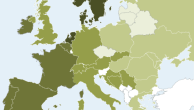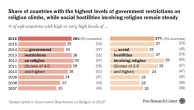Christians are expected to remain the largest religious group in Latin America and the Caribbean in the decades ahead, growing by 25% from 531 million in 2010 to 666 million in 2050.59 The region’s unaffiliated population is forecast to have the largest percentage increase (44%), growing from 45 million in 2010 to 65 million in 2050. The number of adherents of folk religions is projected to grow by 43%, from 10 million to 14 million.
This analysis does not project the size of religious subgroups. But in many Latin American countries, there has been considerable movement from Catholicism to various Protestant groups and denominations in recent decades, and this movement is expected to continue in coming decades.60

Factors Driving Change
Fertility

The Total Fertility Rate of the religiously unaffiliated population in Latin America and the Caribbean is 2.3 children per woman in the 2010 to 2015 period, higher than the rate for any other religious group in the region. The relatively high fertility of the unaffiliated contributes to the group’s expected growth as a share of the region’s population. The fertility rate of Christians in the region is 2.2, equal to the regional rate and slightly above the replacement level of 2.1 children per woman.
Total Fertility Rates for other religious groups were considerably lower than the regional average and the replacement level.
Age Structure

The median age of the religiously unaffiliated (26) in the Latin America-Caribbean region was slightly younger than that of Christians (27) and the overall population (27) in 2010. By contrast, the median age of Hindus (32) and those belonging to folk religions (35) was considerably higher.
Religious Switching

The religiously unaffiliated population in Latin America and the Caribbean is expected to grow in part because of religious switching. (For information on the impact of religious switching on the demographic projections in this report, see Chapter 1.) In a projection scenario with no religious switching, the unaffiliated share of the region’s population in 2050 (8.0%) would remain about the same as it was in 2010 (7.7%). Taking into account projected patterns of religious switching, however, the unaffiliated share of the population is expected to be nearly 9% by mid-century.
Religious switching also is expected to result in an increase in the proportion of people in Latin America and the Caribbean who identify with folk religions, including Candomblé, Umbanda and Spiritism.61
The Christian share of the region’s population in 2050 is expected to be modestly smaller as a result of religious switching.
Migration
Millions of migrants from Latin America and the Caribbean are projected to move out of the region in the decades ahead, and many are expected to move to the United States. But this northward migration is not expected to dramatically change the religious composition of the Latin America-Caribbean region. Consequently, the report does not show different projection scenarios with and without migration for this region. (For more information on the impact of migration on the demographic projections in this report, see Chapter 1.)




